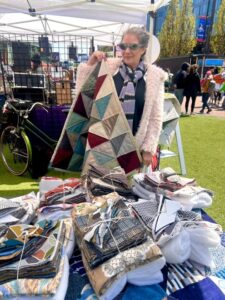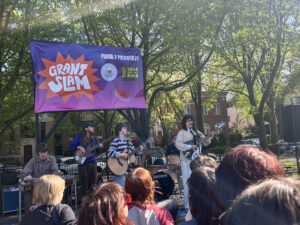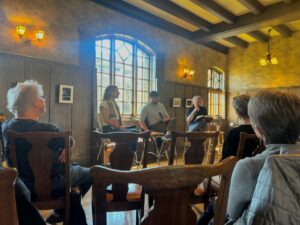Born in Nigeria, Amina Hawkins is an emcee, hip-hop instructor, poet and activist. After briefly living in Chicago during her childhood, her parents moved back to their native land when she was seven years old where she finished her education through high school.
Hawkins said she didn’t exactly fit in since she was viewed as the “American girl,” but still valued her time and experiences in Nigeria while studying under a different educational system.
“I am a little African girl floating through the diaspora on her journey to make her ancestors proud,” Hawkins said.
She embraces this persona by engaging with people of all ages, sharing her cultural practices, performing, educating and serving as an emcee.
Hawkins had an active imagination and developed a passion for writing poetry at the age of nine, often performing for her family using a hairbrush in place of a microphone. After completing one of her first poems, “Thine Eyes,” at age 10, she fell further in love with the freedom words gave her, as well as the ability to express her thoughts in writing.
Around 1988, Hawkins began rapping after a classmate in her poetry class at Harold Washington College told her how much he enjoyed her poems. The classmate encouraged her to join his rap group so she could begin reading her poetry aloud on stage. After performing one of her poems onstage, she felt like she found a new outlet.
The transition into performing as an emcee happened very gradually. When Hawkins started reading poetry out loud on stage in the group, she delivered her words in a cadence similar to that of a rapper. Shortly after, she began to structure her poetry into songs before ultimately releasing her first song, “Not Many Girls,” in 1988.
One of her most memorable experiences growing up in hip-hop spaces and as an emcee was on Aug. 28, 1988, when localKu Klux Klan members ran her and her Master Groove Association rap group out of Chicago’s Marquette Park after being invited to the park to commemorate the anniversary of the Rev. Martin Luther King Jr.’s “I Have a Dream Speech” with a performance. Marquette Park is where King held a march in 1966 before being struck by debris from the rowdy crowd.
The group had reservations about performing in the park out of fear that hostile events similar to King’s own would transpire. But since the park was the place where King’s march took place, Hawkins and her group members felt it made sense to perform there.
“Hip-hop is contemporary and what is happening right now. Hip-hop is for the young and [the] young at heart”
“We were all ready to do our raps, until we saw this group of people who we noticed were wearing white hoods and robes, and then we saw a giant cross and we realized we had driven upon a Ku Klux Klan rally,” Hawkins said.
The KKK members and the people from the neighborhood repeatedly chanted “niggers go home” at Hawkins’ group. “I think I did not know that racism was so real in 1988,” she said. When she left the event, she realized she could use hip-hop to tell a larger story.
Hip-hop culture has been built upon sharing stories through rap. Critics may write the style off as being inconsequential, but hip-hop holds a rich history of politics, social issues and more. “It is the most current connection to Africa that we still have,” Hawkins said. Today, Hip-hop still has cyphers, drums, dance and many more traditions connected with traditional African musical roots.
“Hip-hop is contemporary and what is happening right now. Hip-hop is for the young and [the] young at heart,” she said. “It leaves room for those who probably have aged out to still speak up and express what’s going on in their communities. Hip-hop is deeper than music and fashion, it’s really a consciousness.”
Throughout her time in the hip-hop community, Hawkins has experienced challenges while pursuing her dreams and sharing her gift. She found work promoting shows of her own, as well as those for fellow artists. But working in the hip-hop scene wasn’t void of ostracization. She felt like an outsider because she was not only a female rapper, but also an “earthy girl” who didn’t quite fit in with the typically over-sexualized performers in the industry.
After some time struggling to make ends meet, Hawkins decided to take her future into her own hands and work hard to book her own shows, promote her music and establish herself as an independent artist committed to making things happen on her own terms.
Hawkins is also a part-time faculty member at Columbia College Chicago, and has taught the Hip-Hop: A Sonic History and African American Music Survey courses. She was encouraged to apply to Columbia’s adjunct position by friend and former Academic Partnership Coordinator for the Department of Dance Sage Morgan-Hubbard. After meeting with the music department’s former Associate Chair Nate Bakkum, now senior associate provost, she felt assured that she made the right decision.
Hawkins said the resistance and resilience at the core of hip-hop culture is within her. She embodies hip-hop in her daily life and uses her talents to be an organizer, head of production company Urbanized Music and help establish a hip-hop month for the city of Chicago. Hawkins has dedicated her adult life to making hip-hop not just an art form but a tool for advancing social justice. Through her music, work as an activist and head of her production company, she uses hip-hop as a tool to talk about issues centered around racial equality and social justice. Hawkins said it was the people and elements of hip-hop that made her eager to make a change and use her gift to make a difference in the world. She hopes to continue sharing her gift and doing what makes her happy, which is “playing with ideas, strategizing how things will work and creating art.”








Be First to Comment